Names inscribed on the Equestrian statue of Frederick the Great
The Equestrian statue of Frederick the Great is an outdoor sculpture in cast bronze at the east end of Unter den Linden in Berlin, Germany honoring King Frederick II of Prussia. It was designed in 1839 by Christian Daniel Rauch and unveiled in 1851. It was commissioned by Frederick's great nephew, Frederick William III and dedicated by Frederick's great-great nephew, Frederick William IV.
| Equestrian Statue of Frederick the Great | |
|---|---|
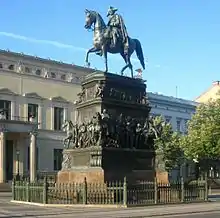 | |
| Coordinates | 52°31′02″N 13°23′34″E |
| Height | 13.5 meters (44 ft)
Statue of Frederick–5.66 meters (18.6 ft) |
| Sculptor | Christian Daniel Rauch |
Depicted on the statue are the four cardinal virtues, several important scenes from Frederick's life, and statues of men important to the founding of the Prussian state. Beneath the statues bronze plaques list the names of military men, philosophers, mathematicians, poets, statesmen, engineers, and others important in Prussia's emergence as a military power in the mid-18th century.
Description and location
The monument is 13.5 meters (44 ft) tall. The statue of Frederick, 5.66 meters (18.6 ft) tall, depicts the King in military uniform and an ermine-trimmed cloak, wearing his decorations and his bicorne hat. In his left hand, he holds the reins of his horse's bridle, and in his right, he holds his walking stick/sword.[1]
The statue itself is also mounted on an unusually tall pedestal, or plinth, 7.84 meters (25.7 ft).[1]
- Locale of the Statue
 Artistic representation of locale
Artistic representation of locale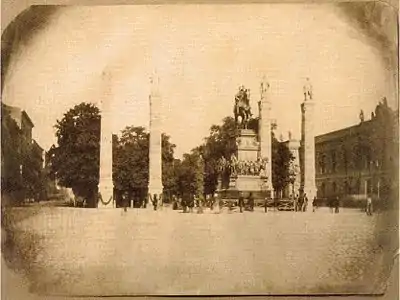 Oldest known photograph of the statue
Oldest known photograph of the statue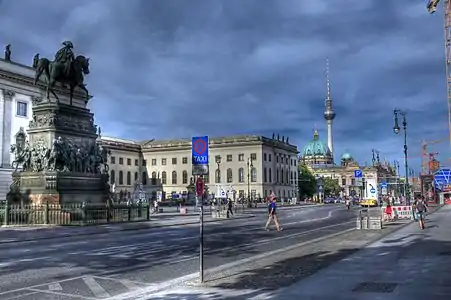 View down the Unter den Linden in Berlin of the stature of Frederick the Great, Humboldt University, and the Berliner Dom.
View down the Unter den Linden in Berlin of the stature of Frederick the Great, Humboldt University, and the Berliner Dom.
Sculptures
The upper section sculpted band, immediately below the statue of the King, shows in bas-relief the King's life and is garnished at the corners with emblems of the four cardinal virtues.[2]
- The Virtues
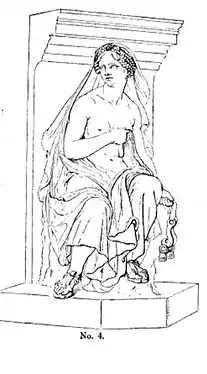
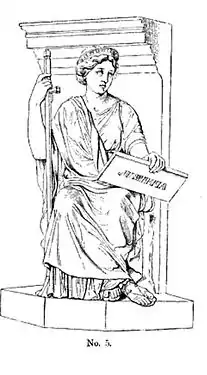
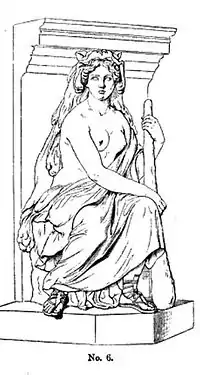
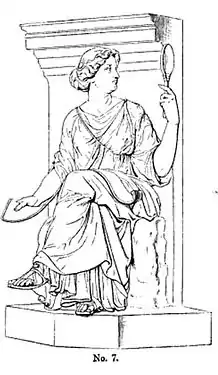
The middle band depicts 74 men of Frederick the Great's time in life-size; some, such as the figure of his brother August, are free standing; others are depicted in high relief. A few, including James Keith, are in bas-relief. Like the first band, four figures mounted on horseback stand at the corners: Frederick's brother, Henry, Charles Wilhelm Ferdinand, Prince of Braunschweig, Friedrich Wilhelm von Seydlitz, and Hans Joachim von Zieten.[1]
The lowest band lists names of additional key figures from Frederick's reign, pressed in bronze.[1]
Relief figures
Mounted
Four mounted figures stand at the corners of the plinth, immediately below Frederick's statue.[2]
- Four Mounted Figures
.jpg.webp) Lieutenant General and Inspector of Cavalry Friedrich Wilhelm von Seydlitz, (1721–1783).[3]
Lieutenant General and Inspector of Cavalry Friedrich Wilhelm von Seydlitz, (1721–1783).[3].jpg.webp) Field Marshal Ferdinand, Prince of Brunswick-Lüneburg (1721–1792).[4]
Field Marshal Ferdinand, Prince of Brunswick-Lüneburg (1721–1792).[4].jpg.webp) Prince Henry of Prussia, (1726–1802). Prince of Prussia. Frederick's brother.[5]
Prince Henry of Prussia, (1726–1802). Prince of Prussia. Frederick's brother.[5].jpg.webp) Lieutenant General and General of Cavalry Hans Joachim von Zieten, Zieten aus dem Busch, (1699–1786).[6]
Lieutenant General and General of Cavalry Hans Joachim von Zieten, Zieten aus dem Busch, (1699–1786).[6]
Standing, full figures
Between the mounted figures stand 25 of the key men of Frederick's career. Some of them are full-sized free-standing figures and several are partially carved in relief.[2] The figures represented are predominantly military, but also include six men of note, including diplomats, the Prime Minister of Prussia, jurists, poets, artists, and philosophers.[1]
indicates that the names are in bas-relief.
| Lieutenant General Johann Dietrich von Hülsen, 1693–1767. Infantry. A man of legendary profanity, Governor of Berlin, and commander of armies at Lobositz and Torgau. Fought in five Prussian wars. [7] |
Lieutenant General Karl Wilhelm von Dieskau, 1701–1777. Artillery. General Inspector of Artillery. Designed new field guns, and organized the training of the horse artillery.[8] |
| Lieutenant General Heinrich Sigismund von der Heyde, 1703–1765. Grenadier Battalion #4. Maintained the heroic defense at the three Sieges of Kolberg.[9] |
Lieutenant General Frederick II Eugene, Duke of Württemberg, 1732–1797.[10] |
| Major General Hans Sigismund von Lestwitz, 1718–1788. His timely attack at the Battle of Torgau secured the victory and saved the army.[11] |
Lieutenant General Wilhelm Sebastian von Belling, 1719–1779.[12] |
| General of Cavalry Joachim Bernhard von Prittwitz-Graffron, 1726–1793. Cavalry. Proprietor of the Regiment Gendarmes. Saved the King's life at the Battle of Kunersdorf.[13] | General of Infantry Prince Augustus William of Prussia, 1722–1758, father of Frederick William II.[14] |
| † Field Marshal James Keith, 1693–1757. Infantry. Close friend and confidante of the King. Killed at the Battle of Hochkirch.[15] | General of Cavalry Dubislav Friedrich von Platen, 1714–1787. Cavalry. Watched his two sons die at the Battle of Zorndorf. Successfully invaded Bamberg, taking many captives and gold.[16] |
| Field Marshal Leopold II, Prince of Anhalt-Dessau, 1700–1751.[17] | † Major General Frederick Francis of Brunswick-Wolfenbüttel, 1732–1758. Brother of the Queen, killed at the Battle of Hochkirch.[18] |
| Field Marshal Friedrich Leopold, Graf von Gessler, 1688–1762. Cavalry. During attack of the Bayreuth Dragoons at the Battle of Hohenfriedburg, his regiment captured 62 enemy flags. [19] | (DOW) Lieutenant General Hans Karl von Winterfeldt, 1707–1757, Frederick's trusted advisor, founder of Prussian military intelligence unit, diplomat.[20] |
| Lieutenant General Carl Heinrich von Wedel, 1712–1782. Infantry. His regiment was so successful at the Battle of Leuthen that 14 members received the Pour le Mérite.[21] | Gotthold Ephraim Lessing, 1729–1781, Philosopher.[22] |
| Prince Augustus Ferdinand of Prussia, 1780–1813, brother of the King.[23] | Count Karl-Wilhelm Finck von Finckenstein, 1714–1800, Diplomat, Prime Minister of Prussia (54 years).[24] |
| Field Marshal Leopold I, Prince of Anhalt-Dessau, 1676–1747, the Old Dessauer. Talented drill master who modernized Prussian infantry.[25] | Ernst Wilhelm von Schlabrendorf, 1719–1769, Prussian state minister in Silesia and Pomerania.[26] |
| † Field Marshal Kurt Christoph, Graf von Schwerin, 1684–1757. Infantry. A member of the military court that tried Frederick for desertion in 1730. Killed at the Battle of Prague.[27] | Johann Heinrich von Carmer, 1720–1801. Chancellor and First Minister of the Justice for Frederick and his nephew. Prussian jurist, and judicial reformer. Rewrote Prussian legal code. Authored Corpus Juris Fridericianum.[28] |
| Major General Frederick William von Kleist, 1724–1767. Cavalry. Commander of the Green Hussars. Commanded an independent corps that participated in the Glorious Raid of 1762.[29] | Carl Heinrich Graun, 1704–1759. Prussian tenor and composer.[30] |
| Lieutenant General Karl Christoph von der Goltz, 1707–1761. Infantry. Charged with defense of Glogau.[31] | Immanuel Kant, 1724–1804. Philosopher.[32] |
| †Hartwig Karl von Wartenberg 1711–1757. Hussar. Major General. Killed in action at Alt-Bunzlau.[33] |
- Relief Figures
.jpg.webp) Mounted (left): Duke Ferdinand. Partial Relief: Augustus and Belling. Foreground: Kleist, Dieskau, Winterfeldt. Mounted (right): Seydlitz.
Mounted (left): Duke Ferdinand. Partial Relief: Augustus and Belling. Foreground: Kleist, Dieskau, Winterfeldt. Mounted (right): Seydlitz..jpg.webp) (left to right) Joachim Bernhard von Prittwitz, Hans Sigismund von Lestwitz, Prince Augustus William of Prussia, Heinrich Sigismund von der Heyde, Johann Dietrich von Hülsen
(left to right) Joachim Bernhard von Prittwitz, Hans Sigismund von Lestwitz, Prince Augustus William of Prussia, Heinrich Sigismund von der Heyde, Johann Dietrich von Hülsen.jpg.webp) Mounted (to the left): Seydlitz, Count Finckenstein, Schlabrendorf, Graun, Count von Carmer, Lessing, Kant, Mounted (to the right): Zeiten
Mounted (to the left): Seydlitz, Count Finckenstein, Schlabrendorf, Graun, Count von Carmer, Lessing, Kant, Mounted (to the right): Zeiten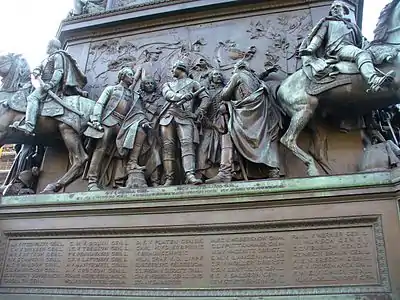 Dessau and Schwerin appear in partial relief. Foreground: Gessler, Wedel, the "Young Dessauer", Wartenberg, Freiherr von der Golz.
Dessau and Schwerin appear in partial relief. Foreground: Gessler, Wedel, the "Young Dessauer", Wartenberg, Freiherr von der Golz.
Inscriptions
The names of Frederick's generals are inscribed on bronze plates, mounted around the plinth.[2]
South face
The south face displays bronze plaques with the names of 25 generals.[1]
| General of Artillery Christian Nicolaus von Linger, 1669–1755. Artillery. Son of a master armorer. Founded Prussian Artillery.[34] |
Field Marshal Hans von Lehwaldt, 1685–1768. Grenadier Guards. Reliable favorite of Frederick; he mentored Frederick's up-and-coming officers.[35] |
| Major General Prince Augustus Ferdinand of Prussia, 1730–1813. Infantry. Brother of Frederick. Grandson of George I of Great Britain.[36] | Lieutenant General Friedrich Rudolf von Rothenburg, 1710–1751. Dragoons. Friend of the King, member of the Round Table of Frederick's closest friends.[37] |
| Lieutenant General Nikolaus Andreas von Katzler, 1696–1760. Gens d'armes. Entrepid soldier.[38] | Field Marshal Wilhelm Dietrich von Buddenbrock, 1672–1757. Cavalry. Companion of Frederick's father.[39] |
| † Lieutenant General Friedrich Sebastian Wunibald Truchsess zu Waldburg, 1677–1745. Infantry. aka Trux, Diplomat. Trusted confidante of the King. Died at the Battle of Hohenfriedburg.[40] | Field Marshal Prince Moritz of Anhalt-Dessau, 1712–1760, Infantry. Sixth son of the Old Dessauer. Promoted on the field after the Leuthen.[41] |
| (DOW) Lieutenant General Heinrich Karl Ludwig de Herault, 1689–1757. Infantry. Died of injuries received at the Battle of Prague. Descended from Huguenot refugees.[42] | Lieutenant General Christoph II von Dohna, 1702–1762. Infantry. Commanded various infantry regiments: Nr. 4; Nr. 23; Nr.16.[43] |
| Field Marshal Christoph Wilhelm von Kalckstein, 1682–1759. Infantry. Frederick's tutor; also supervisor of the Charité hospital in Berlin.[44] | Lieutenant General Ernst Christoph von Nassau, 1686–1755. Cuirassier. Saved the King and his army when they were trapped at Koeniggratz in 1745.[45] |
| Lieutenant General Charles Frederick Albert, Margrave of Brandenburg-Schwedt, 1705–1752. Infantry. Frederick's cousin, Grand Master of Order of Saint John (Bailiwick of Brandenburg).[46] | Lieutenant General and General of Infantry Heinrich August de la Motte Fouqué, 1698–1774. Füsiliers. Friend of Frederick's, one of the few permitted to visit him during his incarceration at Küstrin. Grand Master of the Order of Bayard, a group of Frederick's friends. Descended from Huguenot refugees.[47] |
| Major General Christoph Ludwig von Stille, 1686–1752. Infantry. Educated man who spoke several languages and introduced Frederick to poets and philosophers.[48] | Field Marshal Joachim Christoph von Jeetze, 1672–1753. Infantry. Instrumental in the victory at Kesseldorf in 1745. Suffered a fatal stroke while visiting Frederick in Potsdam.[49] |
| General of Infantry Peter Ludwig du Moulin, 1681–1756. Infantry. Quartermaster of Field Armies. Descended from Huguenot refugees.[50] | Lieutenant General Augustus William, Duke of Brunswick-Bevern, 1715–1781. Infantry. Conducted the defensive campaign of 1757–1758 with great skill.[51] |
| Lieutenant General Georg Ludwig von Schleswig-Holstein-Gottorf, 1719–1763. Infantry. Dismissed in 1761, he served briefly in Russia Army and retired to Holstein to start a Faience factory.[52] | † Lieutenant General Kaspar Ernst von Schultze, 1691–1757. Life Guards. Initially in artillery; joined Frederick's own Life Guard regiment in 1732. Killed at the Battle of Breslau.[53] |
| Field Marshal Dietrich of Anhalt-Dessau, 1702–1769. Infantry. Third son of the legendary Old Dessauer.[54] | † Lieutenant General Frederick William of Brandenburg-Schwedt, 1714–1744. Foot Guards. Cousin of the King. Died at the Siege of Prague after being struck by a cannonball.[55] |
| Lieutenant General Friedrich Wilhelm Quirin von Forcade de Biaix, 1698–1765. Infantry. Succeeded his father as Proprietor of the 23rd Infantry Regiment. Twice wounded and left for dead on the battlefield. Fathered 23 legitimate children with the same woman. Descended from Huguenot refugees [56] | Lieutenant General Kaspar Ludwig von Bredow, 1685–1773. Foot Guards. Frederick's military mentor. Accompanied Frederick on his early campaigns in the Rhineland; served as intermediary between Frederick and his estranged father.[57] |
| Lieutenant General Franz Karl Ludwig von Wied zu Neuwied, 1710–1765. Infantry. Proprietor of the 41st Infantry Regiment. Reliable field commander. Retired with broken health.[58] |
North face
The north face contains the names of 32 of key military figures in Frederick's life. Thirty-two are generals; three are men who contributed significantly to various battles but because of early deaths did not reach the highest military rank.[1]
| Lieutenant General August Friedrich von Itzenplitz, 1693–1759. Infantry. In 1759 led a raid against Bamberg and eluded the Imperial army.[59] | Lieutenant General Georg Wilhelm von Driesen, 1700–1758. Curaissers. Instrumental in the Battles of Prague and Leuthen. Died of gout.[60] |
| Lieutenant General Wolf Frederick von Retzow, 1699–1758. Grenadiers. Started a weaver's colony near Potsdam at Frederick's orders. Refused a suicide mission preliminary to Battle of Hochkirch and was removed from command.[61] | Lieutenant General Otto Magnus von Schwerin, 1701–1777. Dragoons. Led the Bayreuth Dragoons at the Battle of Hohenfriedberg. His opinions often placed him in conflict with the King, so he was never raised to comital status[62] |
| (DOW) Lieutenant General Arnold Christoph von Waldow, 1672–1734. Cavalry. Commanded left wing at Chotusitz[63] | Major General Gustav Bogislav von Münchow, 1686–1766. Frederick's Valet de chambre when he was still Crown Prince. Envoy to Vienna in 1740.[64] |
| Major General Johann Carl Friedrich zu Carolath-Beuthen, 1716–1791. Cuirassier. Started in Austrian service, and transferred to Prussian service in 1741. Served as a diplomat in Poland.[65] | Lieutenant General Kasimir Wedig von Bonin, 1691–1752. Cavalry. Instrumental in the victory at Hohenfriedburg.[66] |
| Lieutenant General Joachim Christian von Tresckow, 1698–1762. Infantry. The King considered him among the good generals. Tresckow defended the city of Neisse after the Prussian loss at Hochkirch, waiting for relief from the main army.[67] |
(DOW) Lieutenant General Peter von Pennavaire, 1690–1759. Cavalry. Proprietor of the Cuirassier Regiment Nr. 11. Nicknamed the "Anvil" because he was beaten so often. Descended from Huguenot refugees.[68] |
| Lieutenant General Christoph Friedrich von Lattorf, 1696–1762. Infantry. Resisted the Austrian siege at Kosel until relieved by General von der Golz.[69] | Lieutenant General Heinrich von Manteuffel, 1696–1778. Infantry. At the Battle of Prague (1757), he picked up the fallen colors of his regiment and led them in a successful assault on the Austrian lines.[70] |
| Lieutenant General Anton von Krockow, 1714–1778. Infantry, Dragoons. Adjutant for Frederick. [71] | Major General Dubislav Friedrich von Platen, 1714–1787. Cavalry. Watched as two of his sons died at Zorndorf; participated in the 1759 raid on Bamberg with von Kleist.[72] |
| Major General Carl Wilhelm Ferdinand von Braunschweig, 1735–1806. Military theoretician.[73] | Major General Wilhelm Graf v. d. Lippe-Bückeburg 1724–1788. Military theoretician.[74] |
| Lieutenant General Friedrich Wilhelm von Gaudi, 1725–1788. Frederick's aide-de-camp. Identified French movement at Rossbach that allowed Frederick to outflank them. Inspector of the Regiments in Westphalia. Descended from Scottish refugees. [75] | Lieutenant General Carl Heinrich von Wedel, 1712–1782. Infantry. Successful regimental action during the Battle of Leuthen resulted in award of 14 Pour le Mérite. Badly wounded at Kunersdorf and retired.[76] |
| † Lieutenant General Moritz Franz Kasimir von Wobersnow, 1708–1759. Killed at the Battle of Kay.[77] | † Major General Georg Ludwig von Puttkamer, 1715–1759. Hussars. Killed at the Battle of Kunersdorf.[78] |
| Colonel William Dietrich von Wakenitz, 1728–1805. Cuirassier. Proprietor of the Cuirassier Regiment Nr. 5. Considered by some of his contemporaries to be among the best commanders in the army, but his enemies blocked promotions. Transferred to Hessian service.[79] |
† Major Siegmund Moritz William von Langen, 1704–1758. Hero of Hochkirch; his company held the Hochkirch cemetery long enough for the Prussian army to organize its retreat.[80] |
| Colonel Karl Friedrich von Moller, 1690–1762. Artillery. Brilliant artillery commander able to see at a glance how to establish his batteries. Instrumental at the Battle of Rossbach.[81] | Lieutenant General Robert Scipio von Lentulus, 1714–1786. Originally in Austrian service, but recruited by the Old Dessauer to join the Prussian military. Well traveled, educated man, served on several diplomatic missions for Frederick. Governor of Neuchâtel, part of Hohenzollern territory.[82] |
| Lieutenant General Friedrich Christoph von Saldern, 1719–1785. Infantry. Codified military training and tactics.[83] | Lieutenant General and General of Infantry Joachim Friedrich von Stutterheim, 1715–1783. Infantry. Fought in all of Frederick's wars.[84] |
| Lieutenant General Paul von Werner, 1707–1785. Hussars. Recruited from Habsburg service by Hans Karl von Winterfeldt. [85] | Lieutenant General Johann Jakob von Wunsch, 1717–1788. Infantry. Soldier of Fortune. Joined Frederick for Seven Years' War. Developed Prussian light infantry tactics.[86] |
| Lieutenant General Christoph Karl von Bülow, 1716–1788. Cavalry. Reliable commander of various cavalry regiments throughout the Seven Years' War. In the War of Bavarian Succession, he commanded the entire right wing.[87] | Lieutenant General Heinrich Gottlob von Braun, 1717–1798). Grenadiers, Participated in Frederick's funeral procession.[88] |
| Lieutenant General Asmus Ehrenreich von Bredow, 1693–1753. Infantry. Proprietor of the Infantry Regiment 21, inducted into Prussian Academy of Sciences in 1753.[89] | Lieutenant General Hans-Friedrich von Krusemark, 1720–1775. Cavalry, Gens d'armes. Inspector of cavalry. Appointed to Frederick's general staff.[90] |
| Field Marshal Wichard von Möllendorf, 1724–1816. Cavalry. Fought in all Prussian Wars from 1741 to 1806. Wounded and captured at Jena-Auerstadt in 1806, Napoleon awarded him the Cross of the Legion of Honor.[91] |
West face
The west face includes 14 men who contributed to the Prussian state as diplomats, authors, jurists, architects, painters and poets.[1]
| Ewald Friedrich von Hertzberg, 1725–1795. Statesman, diplomat, author. Especially notable in the diplomatic expansion of Prussian territories.[92] | Samuel Freiherr von Coccji, 1679–1755. Jurist. Chief Justice.[93] |
| George Wenzeslaus Freiherr von Knobelsdorff, 1699–1753. Painter, architect. Drafted Frederick's drawings of the proposed Sanssouci into architectural plans and directed its construction.[94] | Christian Freiherr von Wolff, 1679–1754. Philosopher, Theoretical philosopher known for ontology or philosophia prima, cosmology, rational psychology, and natural theology. Expelled from Prussia by Frederick William I, and invited back by Frederick. A mountain on the Moon is named for him (Mons Wolff).[95] |
| Carl Wilhelm Ramler, 1725–1798. Poet. Taught logic at the Prussian Cadet school; wrote Tod der Jesu, which was later adapted to oratoria by several musicians (including J.S. Bach). Director of the Royal Theater.[96] | Johann Wilhelm Ludwig Gleim, 1709–1803. Poet. Personal secretary to Frederick William of Brandenburg-Schwedt (above), and accompanied the Prussian army on campaigns in the Silesia wars. Friend of Ewald von Kleist, Garve, Ramler; many of his poems were set to music during the Seven Years' War and became popular as marching tunes and camp ballads. The Gleim Prize is named for him.[97] |
| Christian Garve, 1742–1798. Enlightenment Philosopher, an empirical philosopher, he also translated a portion of Cicero's De Officiis (1783) at Frederick's request. Known also for his translations of Adam Smith's works.[98] | (DOW) Ewald Christian von Kleist, 1715–1759. Poet and soldier, killed at the Battle of Kunersdorf.[99] |
| Johann Friedrich von Domhardt, 1712–1781. State administrator, engineer. Expanded the Angrapa River's flood containment and irrigation systems (1764–1774). Settled 15,000 colonists in East Prussia. Planned the Masurian Canal.[100] | Christian Gellert, 1715–1769. Poet and storyteller. Wrote fables, dramatic comedies, and a psychological novel. [101] |
| Pierre-Louis Moreau de Maupertuis, 1698–1759. Mathematician, First President of the Prussian Academy of Sciences.[102] | Charles-Étienne Jordan, 1700–1745. Literary secretary to Frederick. Author, collector. Descended from Huguenot refugees.[103][104] |
| Johann Joachim Winckelmann, 1717–1768. A Hellenist art historian and archaeologist, he first articulated the difference between Greek, Greco-Roman and Roman art.[105] | Antoine Pesne, 1683–1757. Artist, Court painter. Director of the Berlin Academy of the Arts [106] |
East face
.jpg.webp)
References
Note on sources
Most of this information is derived from the Allgemeine Deutsche Biographie (ADB) and the Neue Deutsche Biographie (NDB) (in German). ADB is a multi-volume biographical dictionary published from 1875–1912 in Leipzig, by Duncker & Humblot. It has been abbreviated as ADB. The volume (Band) date of publication is in parenthesis and the citation includes page numbers. Similarly, NDB is a multi-volume biographical reference work begun in 1953 and scheduled for completion in 2019. It is the successor to the ADB. The 25 volumes published thus far cover more than 21,800 individuals and families who lived in the German language area. The link takes the reader to the wikisource page(s) used in this compilation. Readers can also consult the ADB directly here and the NDB here. When necessary, Anton Balthasar König's Biographisches Lexikon aller Helden und Militärpersonen: Welche sich in preussischen Diensten berühmt gemacht haben (Biographical Dictionary of all those heroes and military figures who have earned fame in the Prussian service), A Wever, 1791, has been consulted. In addition, if several members of a family served during the wars of Frederick the Great, such as the 58 men of the von Kleist family, their full names are linked; otherwise, only one identifying name is used.
Citations
- Denkmal König Friedrich II von Preußen,Senatsverwaltung für Stadtentwicklung und Umwelt, Berlin, revised 10 April 2014 (in German)
- Denkmal König Friedrichs des Großen. Enthüllt am 31. Mai 1851, Verlag der Deckerschen Geheimen Ober-Hofbuchdruckerei, Berlin 1851 (Reprint Leipzig 1987)
- Anton Balthasar König, Biographisches Lexikon aller Helden und Militärpersonen: Welche sich in preussischen Diensten berühmt gemacht haben (Biographical Dictionary of all those heroes and military figures who have earned fame in the Prussian service), A Wever, 1791. v. 4, S. 2
- Paul Zimmermann,Ferdinand, Duke of Brunswick Wolfenbeutel. ADB. Band 15 (1882), S. 272–281.
- Ernst Graf zur Lippe-Weißenfeld, Henry, Prince of Prussia. ADB. Band 11 (1880), S. 561–568.
- Bernhard von Poten, Zieten. ADB, Band 45 (1900), S. 214–220.
- Lippe-Weißenfeld, Hülsen, ADB, Band 13 (1881), S. 334.
- Lippe-Weißenfeld, Dieskau. ADB, Band 5 (1877), S. 147.
- König, Biographisches Lexikon aller Helden und Militärpersonen: T. G-L, A. Wever, 1789, pp 157–160.
- Michel Huberty; Giraud, Alain; Magdelaine, F.; B. (1979). L'Allemagne Dynastique, Tome II, Anhalt-Lippe-Wurtemberg. France: Laballery. pp. 459–460, 474–478, 499–500. ISBN 978-2-901138-02-0.
- Poten, Lestwitz. ADB, Band 18 (1883), S. 457–458
- Lippe-Weißenfeld Belling. ADB, Band 2 (1875), S. 312–313
- Poten, Prittwitz-Graffron. ADB, Band 26 (1888), S. 605–606.
- Richard von Meerheimb, August Wilhelm, Prinz von Preußen. ADB, Band 1 (1875), S. 669–671.
- Arnold Dietrich Schaefer James Keith ADB, Band 15 (1882), S. 551–555.
- Poten, Dubislaw von Platen. ADB, Band 26 (1888), S. 249–251.
- Ferdinand Siebigk. Young Dessauer. ADB, Band 18 (1883), S. 352–356.
- Ferdinand Spehr, Friedrich Franz ADB, Band 7 (1878), S. 505.
- Lippe-Weißenfeld, Geßler. ADB, Band 9 (1879), S. 95.
- Poten, Winterfeldt. ADB, Band 43 (1898), S. 485–490.
- Poten, Wedel. ADB, Band 41 (1896), S. 410–413.
- Carl Christian Redlich, Lessing, Gotthold Ephraim, ADB, Band 19 (1884), S. 756–802.
- Lippe-Weißenfeld , Ferdinand, Prinz von Preußen. ADB, Band 6 (1877), S. 709.
- Siegfried Isaacsohn, Finck von Finckenstein. ADB, Band 7 (1878), S. 22–25.
- Siebigk, Old Dessauer. ADB, Band 18 (1883), S. 336–352.
- Colmar Grünhagen, Schlabrendorf. ADB, Band 31 (1890), S. 316–319.
- Poten. Schwerin, Kurd (Kurt) Christoph. ADB, Band 33 (1891), S. 421–425.
- Georg Friedrich Felix Eberty, Carmer. ADB, Band 4 (1876), S. 1–3.
- Lippe-Weißenfeld, Richard von Meerheimb. Frederick William von Kleist (Green Kleist). ADB, Band 16 (1882), S. 123–124.
- Moritz Fürstenau, Graun. ADB, Band 9 (1879), S. 607–609.
- Lippe-Weißenfeld, Goltz. ADB, Band 9 (1879), S. 357–358.
- "Kant". Random House Webster's Unabridged Dictionary. Accessed 12 March 2017. Carl von Prantl, Kant. ADB, Band 15 (1882), S. 81–97.
- Poten, Wartenberg. ADB Band 41 (1896), S. 193–194.
- Poten Linger. ADB, Band 18 (1883), S. 709–710.
- Poten, Lehwalt. ADB, Band 18 (1883), S. 166–167.
- Lippe-Weißenfeld, Ferdinand, Prinz von Preußen, ADB, Band 6 (1877), S. 709.
- Poten, Rothenburg. ADB, Band 29 (1889), S. 358–359.
- Poten,Katzler. ADB, Band 15 (1882), S. 457–458.
- Lippe-Weißenfeld, Buddenbrock. ADB, Band 3 (1876), S. 500.
- Poten, "Truchseß, Friedrich Sebastian Wunibald Graf.ADB 38 (1894), S. 678-679.
- Ferdinand Siebigk, Moritz, Prince of Anhalt. ADB, Band 22 (1885), S. 263–268.
- Lippe-Weißenfeld Herault. ADB. Band 11 (1880), S. 113.
- Lippe-Weißenfeld, Christoph II von Dohna. ADB, Band 5 (1877), S. 302–303.
- Lippe-Weißenfeld. Kalckstein. ADB, Band 15 (1882), S. 17–18.
- Poten, Nassau, Christof Ernst. ADB, Band 23 (1886), S. 262–263.
- Lippe-Weißenfeld, Karl Friedrich Albrecht, Markgraf von Brandenburg-Schwedt. ADB, Band 15 (1882), S. 263.
- Lippe-Weißenfeld, Fouqué. ADB, Band 7 (1878), S. 201–202.
- Heinrich Pröhle, Stille. ADB, Band 36 (1893), S. 240–245.
- Ernst Friedländer, Jeetze. ADB, Band 13 (1881), S. 751–753.
- Lippe-Weißenfeld, Moulin. ADB, Band 5 (1877), S. 466.
- Meerheimb, August Wilhelm, Herzog von Braunschweig-Bevern. Also called Brunswick-Bevern in English sources. ADB, Band 1 (1875), S. 665–667.
- Lippe-Weißenfeld, Georg Ludwig, Herzog von Holstein-Gottorp. ADB, Band 8 (1878), S. 698.
- König, Schultze, Biographisches Lexikon aller Helden und Militärpersonen: T. M-See, A. Wever, 1790, S. 441–444.
- Siebigk, Dietrich, Fürst zu Anhalt. ADB, Band 5 (1877), S. 172–175.
- König, Frederick William of Brandenburg-Schwedt. Biographisches Lexikon aller Helden und Militairpersonen. Wever, 1788 - Band 1, S. 211–212.
- König, Forcade de BiaixBiographisches Lexikon aller Helden und Militairpersonen. Wever, 1788, Band 1, S. 430.
- König, Kaspar Ludwig von Bredow, Biographisches Lexikon aller Helden und Militairpersonen. Wever, 1788 , Band 1, S. 255.
- Poten, Wied zu Neuwied ADB, Band 23 (1886), S. 558–559.
- Ernst Friedländer, Itzenplitz. ADB, Band 14 (1881), S. 648–649,
- Lippe-Weißenfeld, Driesen. ADB, Band 5 (1877), S. 410–411.
- Poten, Retzow, Wolf Friedrich von, ADB, vol. 28, pp 277–278.
- Poten, Schwerin, Otto Magnus von. ADB, Band 33 (1891), S. 425–426.
- Waldow. ADB, Band 40 (1896), S. 720–721.
- Julius Mebes, Münchow. Beiträge zur Geschichte des Brandenburgisch-Preussischen Staates, Band 1, S. 397.
- Poten, Schönaich-Carolath, ADB, Band 32 (1891), S. 256.
- Gottfried von Bülow, Bonin. ADB, Band 3 (1876), S. 127–128.
- Poten, Tresckow. ADB, Band 38 (1894), S. 576–577.
- Poten. Pennavaire. ADB, Band 25 (1887), S. 356–357.
- Poten, Lattorf. ADB, Band 18 (1883), S. 19–20.
- Poten, Heinrich von Manteuffel. ADB, Band 20 (1884), S. 259–260.
- Poten, Krockow. ADB, Band 17 (1883), S. 174–175.
- Poten, Platen. ADB, Band 26 (1888), S. 249–251.
- Paul Zimmermann, Karl Wilhelm Ferdinand, Duke of Brunswick-Lüneburg. ADB, Band 15 (1882), S. 272–281.
- Rudolf Falkmann, Wilhelm, Graf von Schaumburg-Lippe. ADB, Band 43 (1898), S. 202–203.
- Lippe-Weißenfeld, Gaudy/Gaudi. ADB. Band 8 (1878), S. 419–420,
- Poten, Wedell. ADB, Band 41 (1896), S. 410–413.
- Poten, Wobersnow. ADB, Band 43 (1898), S. 700.
- Poten, Puttkamer. ADB, Band 26 (1888), S. 777–779.)
- Poten, Wakenitz. ADB, Band 40 (1896), S. 635–638.
- Knights of Malta. Brandenburg, Johanniter-Ordensblatt: Amtliche Monatschrift der Balley Brandenburg, Volume 45:52, Berlin, 28 December 1904. Accessed 19 February 2017.
- Poten, Moller, ADB, Band 22 (1885), S. 127–128.
- Poten, Lentulus, ADB, Band 18 (1883), S. 267–268.
- Poten, Saldern. ADB, Band 30 (1890), S. 211–213.
- Poten, Stutterheim, Joachim Friedrich von, ADB, Band 37 (1894), S. 74–75.
- Poten, Werner. ADB, Band 42 (1897), S. 63–66.
- (in German) Albert Pfister. Drei Schwaben in fremden Kriegsdiensten. Graf Harsch. Herwarth von Bittenfeld. Joh. Jak. Wunsch. In: Württembergische Neujahrsblätter 12 (1895), S. 33–50
- Lippe-Weißenfeld, Bülow. ADB, Band 3 (1876), S. 514–515.
- Kurt von Priesdorff, Soldatisches Führertum. Band 2, Hanseatische Verlagsanstalt, Hamburg (no date), S. 100–101.
- Lippe-Weißenfeld, Bredow. ADB, Band 3 (1876), S. 282.
- Poten, Krusemarck. ADB, Band 17 (1883), S. 270.
- Poten, Möllendorff. ADB, Band 22 (1885), S. 120–121.
- Stephan Skalweit, Hertzberg. Neue Deutsche Biographie, 8 (1969), S. 715-717.
- Erich Döhring, Cocceji, Samuel Freiherr von. Neue Deutsche Biographie 3 (1957), S. 301 f.
- Hans Reuther, Knobelsdorff, Georg Wenceslaus. Neue Deutsche Biographie 12 (1979), S. 191-193.
- W. Schrader, Wolff, Christian. ADB. Band 44 (1898), S. 12–28.
- Eberhard Fromm, Ramler. Neue Deutsche Biographie 21 (2003), S. 131.
- Wilhelm Creizenach. Gleim. ADB, Band 9 (1879), S. 228–233.
- Daniel Jacoby, Garve. ADB, Band 8 (1878), S. 385–392.
- Rudolf Schwarze Ewald Christian von Kleist. ADB, Band 16 (1882), S. 113–121.
- Lippe-Weißenfeld. Domhardt, ADB, Band 5 (1877), S. 325–326.
- Kurt Wölfel, Gellert, Christian Fürchtegott. Neue Deutsche Biographie 6 (1964), S. 174-175.
- Reinhold Koser, Maupertuis. ADB, Band 20 (1884), S. 691–693.
- Jonathan I. Israel Radical Enlightenment: Philosophy and the Making of Modernity 1650–1750 2001, Page i.
- Theodor Hirsch, Jordan. ADB, Band 14 (1881), S. 504–506.
- Julius Vogel, Winckelmann. ADB, Band 43 (1898), S. 343–362.
- Franz Weinitz. Pesne. ADB, Band 25 (1887), S. 430–432.
| Wikimedia Commons has media related to Inscriptions at Reiterstandbild Friedrichs des Großen (Berlin-Mitte). |